Here is a short description of our production pipeline, in order to show the diversity of departments for which we are hiring.
If you want to know more about one department, please click on it and a description will appear.
Here is a short description of our production pipeline, in order to show the diversity of departments for which we are hiring.
If you want to know more about one department, please click on it and a description will appear.
All the development of our projects is done internally by Illumination Entertainment.
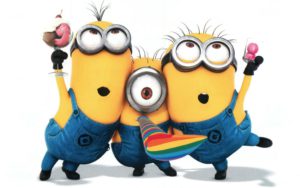
Part of the development of the project along with script writing, concept art lays the foundations of our animation design by producing an idea that aims to capture the visual feel of the project, and serves as a point of reference throughout the entire creative process.
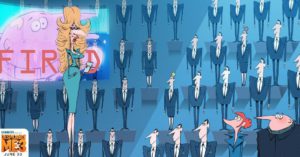
Relying on the script breakdown, storyboarders produce a series of drawings describing, shot by shot, the action of the film. It is the first version of the movie once edited, the animatic.
On the Director’s approval, pictures are given to Editorial who starts editing and adds actors’ voices.

The main role of the Research & Development department is to propose new technologies in order to enhance the level of quality of our films, or the efficiency and the convenience of the production.
The team is responsible for the development and the maintenance of tools that will be either integrated in commercial software (plugins for Maya, Nuke, etc…), or proposed as in-house developed applications, such as the rendering engine or the asset manager.
The Art Department team includes 2 main sub-departments: design and color.
All the designs will provide a basis to the characters and sets&props modeling departments. Concerning the sets, the Art Department will also produce Maya scenes in order to establish the volumes for the implementation of the sets.
The coloring is intended for the surfacing. The Art Department produces reference pictures for the Lighting, Matte Painting and Compositing departments in the form of color scripts and color keys.
An illustrator-graphic designer is also part of the team. His role is to design visuals for posters, product packaging, shop signs, user interface designs (control rooms, dashboards, etc…) that appear in the sets of animated feature films currently in production.
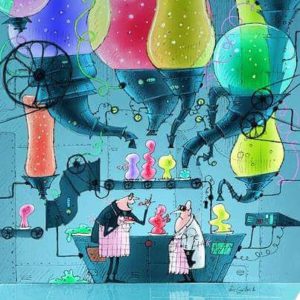
Editorial is a department in the heart of the production process. It produces the references in terms of shots, timing, sound, etc… and receives shots from the other departments in order to include them in the film edit as the project progresses.
The first and second assistants are responsible for the importing of elements coming from the other departments. They also publish the editing of sequences and potential changes approved by the director and the editor so that all departments work with updated references.
Editorial steps in the moment the first images from storyboard are delivered and operates until the completion phase of the film. Therefore the editor works closely with the director throughout the production process.
The IT team is responsible for ensuring the development of the information system (workstations, infrastructure servers, storage servers, network equipment, render farm…) and the availability of hardware and software assets for all employees.
Character Modeling receives the designs from the Art Dep and makes the meshes and shapes of the characters. These meshes will then be sent to Rigging for acting and to Surfacing for texturing.
The Sets & Props Modeling creates the meshes of the sets and props based on the designs and Maya scenes provided by the Art Department. Those meshes are then givent to the Rigging to be actorized and to the Surfacing to be textured.
The Technical Directors team provides support to all the artists, supervisors and production teams.
It also develops several tools intended to the artists (Maya, Nuke, Asset Manager…), to the production team, accounting and archives exploitation.
The Character Rigging department receives meshes and shapes from Character Modeling. They actorize the character with a skeleton, deformers and controllers. They also integrate the CFX rig (clothes and hair). They produce an Actor-Ok for each character that will be used for the Layout and Animation.
The Character Surfacing takes action after delivery of the character by the Modeling department.
The artists have various tools at their disposal to sculpt some type of volume and add numerous details that will bring life to the character.
Working alongside the Hair department and in close collaboration with the Art Director and the Lighting department, the Character Surfacing artists will create the textures, the shaders and an appearance that will adapt to 3D rendering, while keeping the conformity with the initial design.
Implicated in the creative process from pre-production, the Character Surfacing also provides a technical and artistic oversight throughout the production process.
The Sets and Props Rigging department builds the skeleton of the objects produced by the Sets&Props Modeling department. It installs the system (eg. skeleton, deformers, controllers, etc…) that will allow layout and animation to bring life to those objects.
The department will also eventually integrate systems that will help some simulations of CFX (Cloth dynamics such as curtains, napkins, etc…), Hair (grass, carpet, fur) and VFX (vegetation, wreckage) departments. The Set&Props Rigging department is also responsible for the pipeline and the Maya tools used by the departments Sets&Props Modeling, Surfacing and Rigging departments.
Set Surfacing receives the meshes from the Modeling Set with a first UV unfolding. They work on the shaders and textures. They produce a Shading-Ok for each character which will be used for the final rendering in Lighting.
Production is responsible for the smooth running of the manufacture of the movies. Production supervisors, manager and associate production managers (APM) work closely with the directors, producers and department supervisors. There tasks include the establishment and management of budgets, the monitoring of the teams’ schedules and of the production process.
Production ensures the accurate and efficient flow of information and elements between artists and departments.
The Layout sets up the staging of the scenes (camera axes, rhythm of the main action, sequence of shots…). They work on scenes containing several consecutive shots called Masters. Their movies are regularly sent to the Editorial Department to be integrated into the editing process. The validated Masters then go to the Technical Layout to be prepared for the Animation.
The Visual Effects department is cross-functional, contributing to the production throughout the process, from effects’ previzualisation to some rendering for compositing.
The VFX department at Illumination Studios Paris not only produces effects (water, smoke, explosions, snow, clouds…), it also produces natural set elements such as trees, grass, vegetation in general, and tools for crowd simulation.
The VFX department works from Setdress or CFX shots to deliver either to the OCC (pipeline) or compositing department for rendered elements.
The Animation realizes the action of the characters. We distinguish between Animation Main, which deals with the main actors, and Animation Crowd, which deals with the crowds and extras. The animation movies are regularly sent to the Editorial Department to be integrated into the editing process. Once the shot is validated (and very often in the process of finalizing the shot), the VFX team takes the scene in hand to install the special effects. Next, Set Dressing finalizes the layout of the set elements to perfect the composition of the frame and CFX verifies the clothing and hairstyle simulations. The scene is then exported for a first verification rendering: the Occ.
In character-heavy shots, the animation of crowds and extras is handled by the Animation Crowd. These animation layers follow the same process as a Main Animation layer: VFX, CFX and Occ.
Animation Fixing makes a technical check of the animation plans. It is responsible for all “post-anim” elements for the following departments: CFX, VFX, lighting. He offers solutions to improve the management of problematic shots and to optimize the animation pipeline.
The Hair Department works on the meshes of the Character Modeling to install the character hairstyles (cut, volume and shading). The shading will then be sent to Character Surfacing for integration into the Shading-Ok.
The Technical Layout (TLO) department receives the approved shots from the Layout department. The artists check the conformity of all the elements (characters, sets and props) that appear in the shots to obtain consistent and complete scenes. The TLO also produces the layering in order to cut the shots in different layers of animation for the Crowd Animation department.
The shots are then sent to the various Animation departments, who can start its own part of the production process.
The Occ 1 is a first technical pass. It is a strange looking animation video that allows you to see if everything is where it should be. From there, the same shot goes through four different departments.
The Matte Painter usually paints the extension of the shot’s set, from a pre-shot rendered in 3D.
Working from a flat surface, the Matte Painting department paints part of the set of the shot while making sure some empty spaces are left within the image in which one or more shots will be integrated.
The Matte Painting will also create plates which will be integrated by the Lighting or the Compositing department.
It can also be produced on a modeled surface to then be projected. It will create parallax in shots that include camera movement.
The Set Dressing Department dress the sets of all shots with props, furniture and vegetation while refining the graphic and dynamic composition of the overall image.
In order to polish the frame’s composition, the Set Dressing Department finalized the set layout to ensure continuity and to highlight the animated characters’ performance. From the animation main and crowd shots, the Set Dressing team delivers finished shots to the Lighting – Compositing.
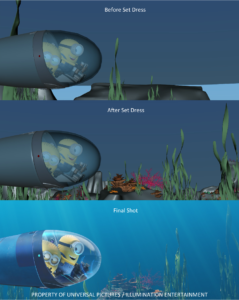
The Visual Effects department is cross-functional, contributing to the production throughout the process, from effects’ previzualisation to some rendering for compositing.
The VFX department at Illumination Studios Paris not only produces effects (water, smoke, explosions, snow, clouds…), it also produces natural set elements such as trees, grass, vegetation in general, and tools for crowd simulation.
The VFX department works from Setdress or CFX shots to deliver either to the OCC (pipeline) or compositing department for rendered elements.
The Visual Effects department is cross-functional, contributing to the production throughout the process, from effects’ previzualisation to some rendering for compositing.
The VFX department at Illumination Studios Paris not only produces effects (water, smoke, explosions, snow, clouds…), it also produces natural set elements such as trees, grass, vegetation in general, and tools for crowd simulation.
The VFX department works from Setdress or CFX shots to deliver either to the OCC (pipeline) or compositing department for rendered elements.
The Character Effects (or CFX) department intervenes twice, at the beginning and at the end of the production process:
Occ 2 is the second technical pass that serves as a final verification of the animation before exporting to the Lighting department.
The Lighting Department receives from the Pipeline Department the final shots, including VFX and CFX, and export them to the in-house rendering software. The Lighting team setups the lights and the mood using Art Department references, and then enhances the lighting quality of each shot.
The Lighting Department works closely with the R&D Department for the development of the rendering software, by adjusting it to the newest technologies and to the specific needs of the film, sequence or shot.
The lighter also supervises the rendering which is calculated on different layers, in order to ensure that the Compositing department, with who he works in pair, can work efficiently.
At last, alongside the Compositing and Surfacing Departments, the Lighting Department ensures the rendered movie quality, by refining and correcting all the visual details of each shot.
Finally the Lighting team masters the technical aspects of the rendering software, as they control image quality and rendering duration.
Compositing is the last stage of an animated film production process, just before the general grading at DI.
Compositors put together the layers coming from lighting and matte painting with the software Nuke, and give the final artistic look to the image, working closely with the director and the artistic director.
Compositing includes grading, integration, optical effects (depth of field, flares, camera lens distortion, etc…), effects (NukeX particles), all that while emphasizing on the character animation and the visual narrative.
Lighting and Compositing deptaments are always working in pair, on the artistic look of the film, the layering and the different technical issues they might encounter.
Compositors also produce some of the stereo-graphic images.
Description coming up!
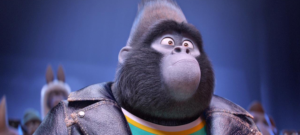
Stereo is involved in the Layout to set up the stereo camera settings. They define the IOC (inter-ocular), the HIT (horizontal image translation) and the Toe (convergence) to adjust the stereo. They intervene in Animation and finalize their settings in Compositing.
